1lumen selects and reviews products personally. We may earn affiliate commissions through our links, which help support our testing.
Armytek Prime C2 Pro Max Magnet USB review
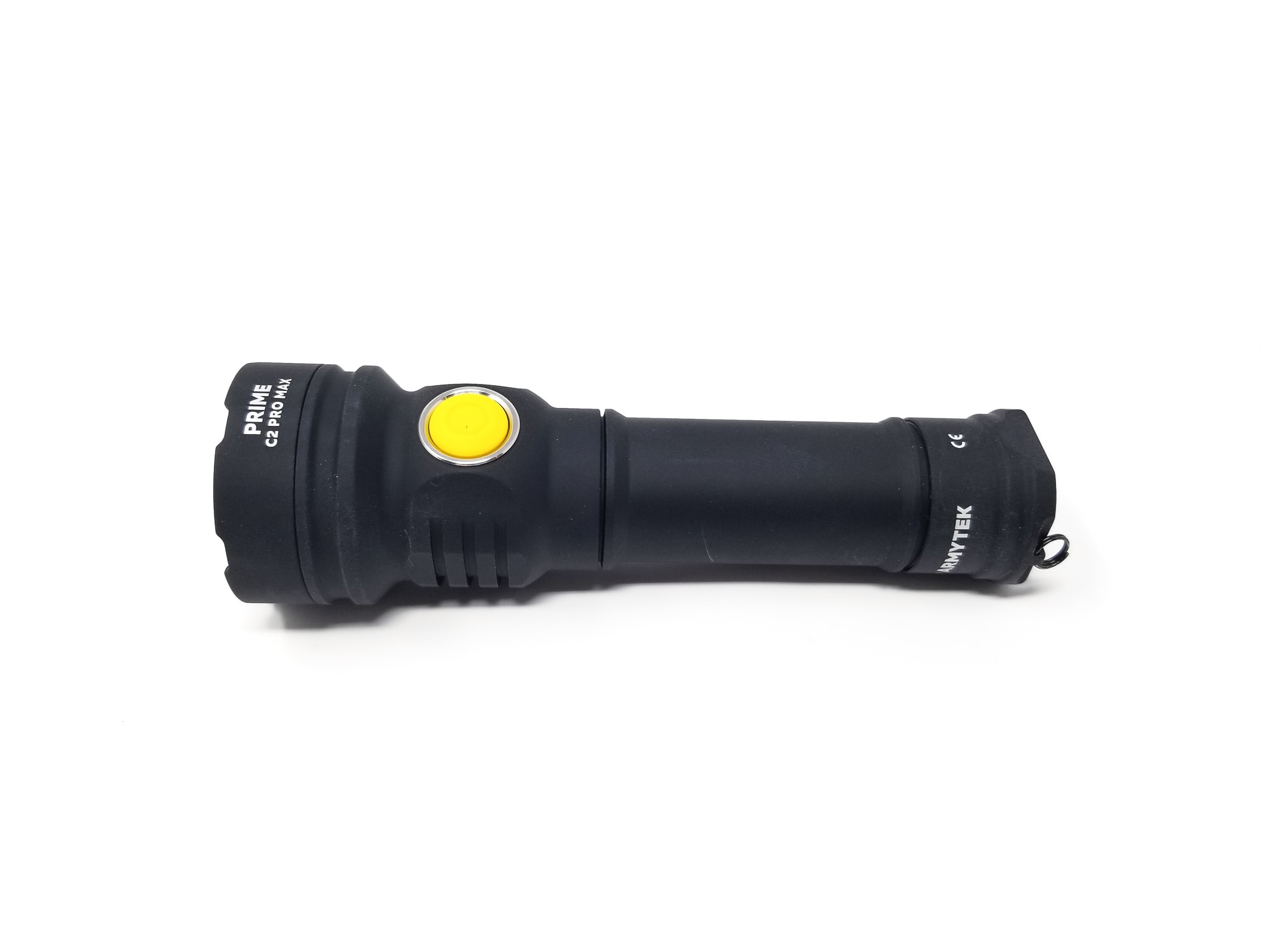
Armytek Prime C2 Pro Max Magnet USB specs
| Brand & Model | Armytek Prime C2 Pro Max Magnet USB |
|---|---|
| Flashlight category | General Purpose/EDC |
| LED | 1*Cree XHP70.2 |
| Max. output | 4,000 lumens |
| Max. beam distance | 260 meters |
| Max. beam intensity | No data |
| Battery config. | 1*21700 or 1*18650 |
| Onboard charging | Proprietary Magnetic |
| Main modes | 10+6 (two mode groups) |
| Blinkies | Strobe |
| Waterproof | IP68 |
| Review publication date | November 2023 |
Review intro:
Full disclosure: Armytek isn’t a brand I have much experience with, and that’s okay! I’m actually looking forward to this one because of that. Armytek has a lot of experience in the portable illumination industry and quite a story to go with it. The name Armytek came from the modus to produce products meeting military spec for durability and reliability (makes sense). They’ve been making flashlights since 2007, and were early adopters of LED technology.
They’re based out of Germany, but have a presence in several countries globally. Armytek as a legit brand really broke out in a big way in 2009, opening their own manufacturing facility in China. Yep, Armytek doesn’t rely on an OEM like Astrolux or Wurkkos; it’s all in-house. This helps improve quality control by closely monitoring and controlling the manufacturing, design, development, and testing process. That’s good for business and consumers!
Spanning 32 products, Armytek’s lineup has something for everyone in many different use-cases (and some interesting naming conventions to boot with names like Elf, Crystal, Wizard, Zippy, and my favorite, Barracuda and Viking. Today, I’ll be taking a look at a relative newcomer to their Prime product line of EDC/utility lights, the C2 Pro Max Magnet USB. This is the 2nd generation of the C2 Pro, a single 21700 light sporting a single LED, magnetic charging (a-la Olight style), and a very unique UI. The Prime C2 Pro Max is the top-of-the-line in the Prime line and has great specs. Let’s see how Armytek’s finest stacks up.
Package quality.
Armytek sells in retail and online outlets, so packaging is important, and Armytek gives you nice, retail-friendly packaging with lots of colorful graphics and feature blurbs. Inside is a molded plastic tray holding all the bits. Here’s what you get:
- Armytek Prime C2 Pro Max Magnet USB
- Proprietary charging cable
- 2 o-rings
- Armytek branded 5000 mAh flat top 21700
- Lanyard with quick release clasp and split ring attached
- Holster
- User manual
This is a complete, ready to go kit with all you need to unlock the light and get to work, typical of the competition in this class. The included battery doesn’t seem protected in any way shape or form and is just a standard flat top. The holster is nice though, and the lanyard has a clasp clip on the end with a split ring installed for attaching to the flashlight, but the split ring was more of a nuisance than a convenience, and the manual is a bit sparse for operating instructions and the UI (which would have been nice since the UI’s a doozy).
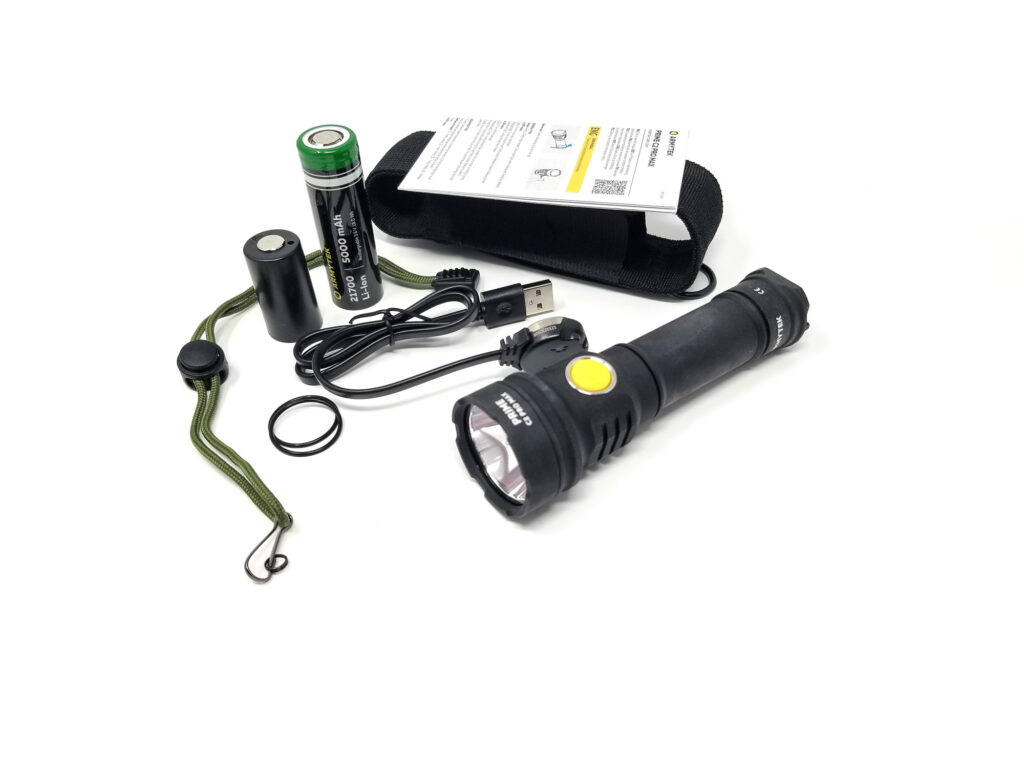
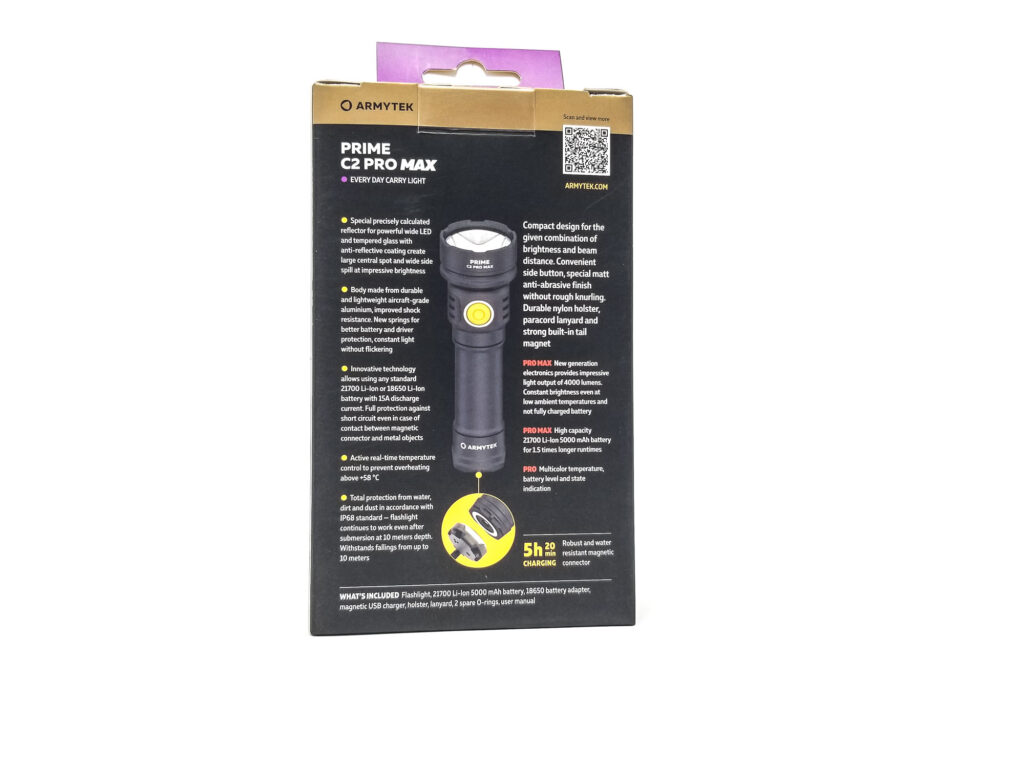
Flashlight in use, Build Quality, and Warranty
The Prime C2 Pro Max Magnet represents the top-of-the-line model in the Prime product line. It’s smaller than a C8 pattern light, and is right at home for general purpose/utility duties, and can also do EDC duty. It’s small enough that it can be pocket carried, but the holster is probably better. The included holster is for bezel up carry only, and it’s a decent quality one with a belt loop and a lanyard/carabiner attachment point.
The handling is good with a balanced feel and good manners. It just feels good in the hand, and I think it would fit many hand sizes just fine in all the grip positions (over/under hand, saber, ice pick). The finish is delightfully grippy and afforded good control despite the absence of knurling or texturing. The tailcap has flats cut into it for anti-roll and they work great!
There’s a magnet in the tailcap, and it’s strong enough to hold the C2 Pro Max at a 90 degree angle from a flat surface. The switching is handled by a single e-switch up front. The bezel is shiny, and the boot is Armytek yellow (nice touch). It’s proud and grippy, and had great feel and click action. It was also easy to locate by feel. It is backlit, but that’s a bit mysterious since nothing’s mentioned in the manual about it. It doesn’t illuminate when the light is on, but it does blink when you click the switch, either orange, green, or red (when the battery gets low), and blinks once every 5 seconds when on standby.
Quality-wise, Armytek positions themselves towards the upper end of the market, up with Acebeam, Olight, Fenix, Nitecore, etc. This is my first Armytek light, and so far so good! The light is very well-made and has awesome quality. It’s priced right at around $115 US which is in line with the competition, and it’s worth it. The Prime C2 Pro Max is made from 6061-T aluminum, and the machining is perfect. There’s no sharp edges, no blemishes or tool marks anywhere. and it passed the maracas test. The reflector is flawless as well. The finish is type III HA hard anodizing, and it’s done in this ultra-matte, super grippy black finish a bit like a chalkboard. While I really like the finish, it is prone to showing scratches and scrapes from abrasion, and will actually scratch off certain materials (the finish is pretty hard) so be aware of that.
The battery tube is fixed to the tube, and the rest of the light is glued up. Only the tailcap unscrews. The rear threads are bare (so is the inside of the tube!) rectangular cut and smooth with lot of lube. For springs, the tailcap has a very long coil spring, and the driver also has a smaller spring for shock absorption, something I expect on a premium light. The rear threads are bare, thick square cut units, and have plenty of lube. Even though the threads are bare, you can still mechanically lock the light out. The tailcap takes a full 5 ½ turns to seat, and about 3 turns in it has a lot of resistance, so you need a kung-fu grip to tighten it. The tailcap is sealed with dual o-rings, and Armytek gives it an IP68 rating so no worries about dunking your C2 Pro Max in the lake (or toilet).
Warranty? Armytek is up there with the heavy hitters in the industry, with an extremely generous warranty program. From Armytek.com:
10 years — flashlights made of aircraft-grade aluminum.
5 years — flashlights made of polycarbonate and battery chargers.
2 years — mounts, remote switches, color filters, power supplies, interchangeable tailcap for diving, components for battery chargers, components for aircraft-grade aluminium flashlights (batteries, headmounts, bicycle mounts, Micro USB and Magnet USB charging cables, buttons and connectors).
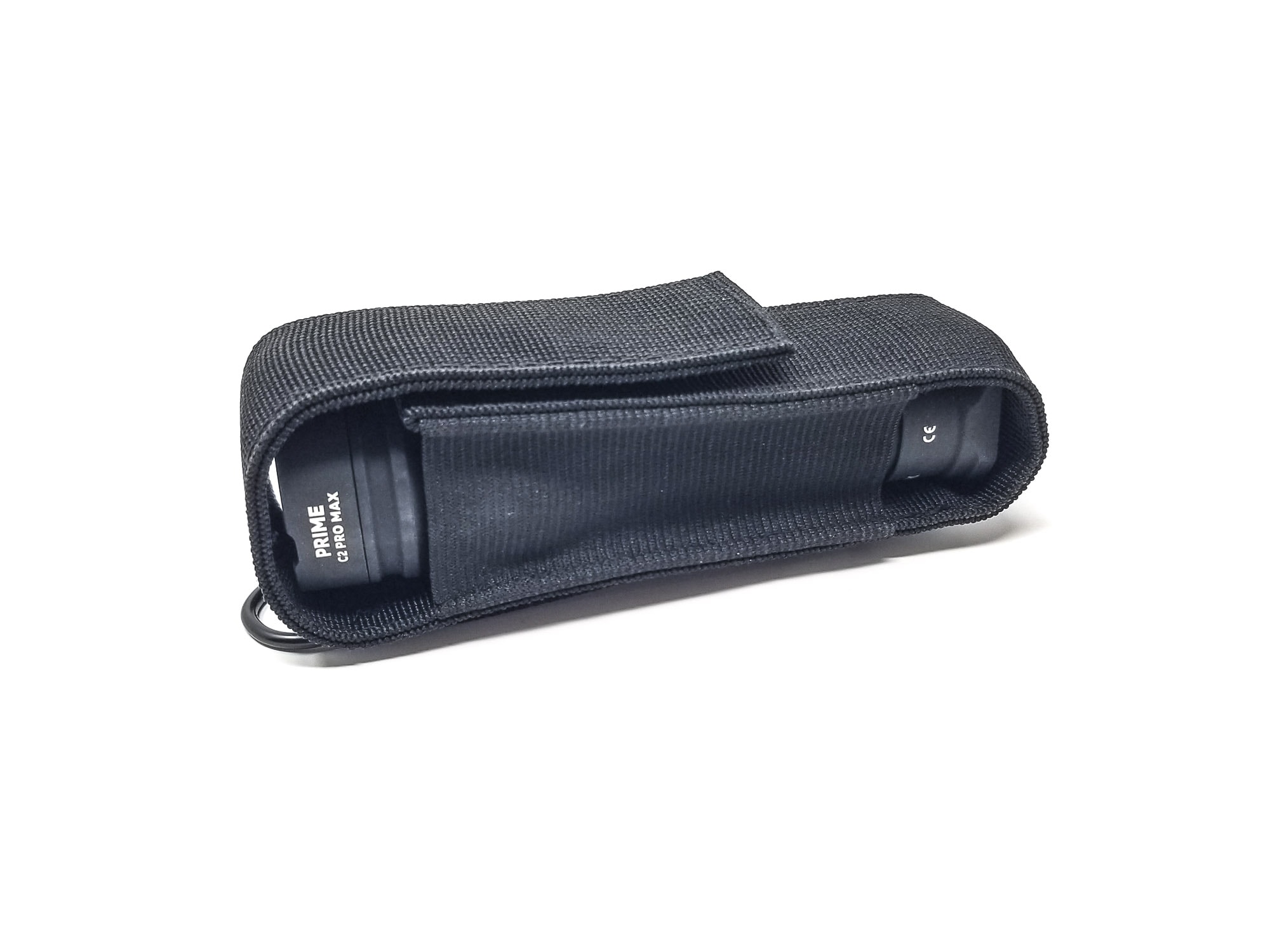
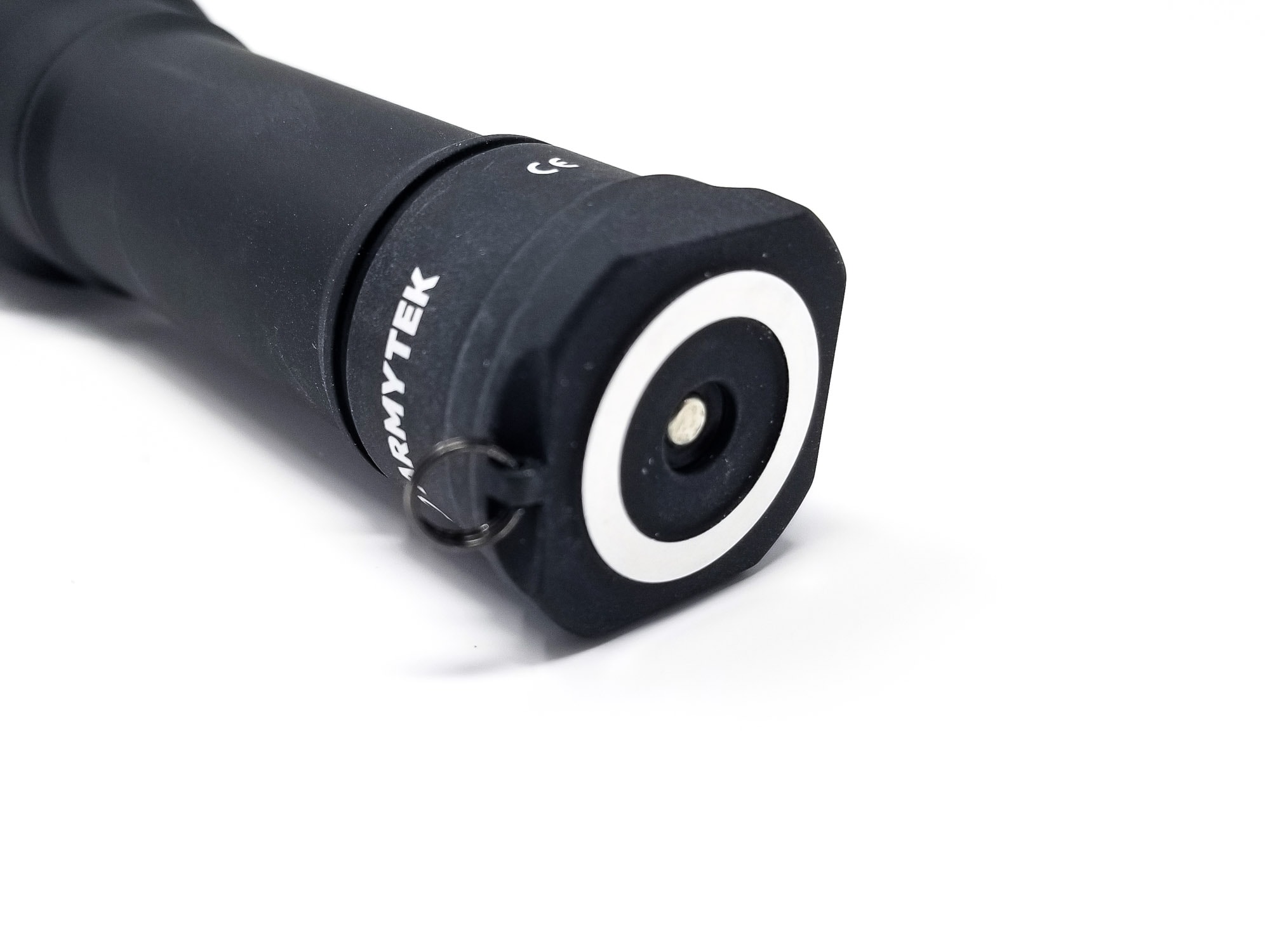
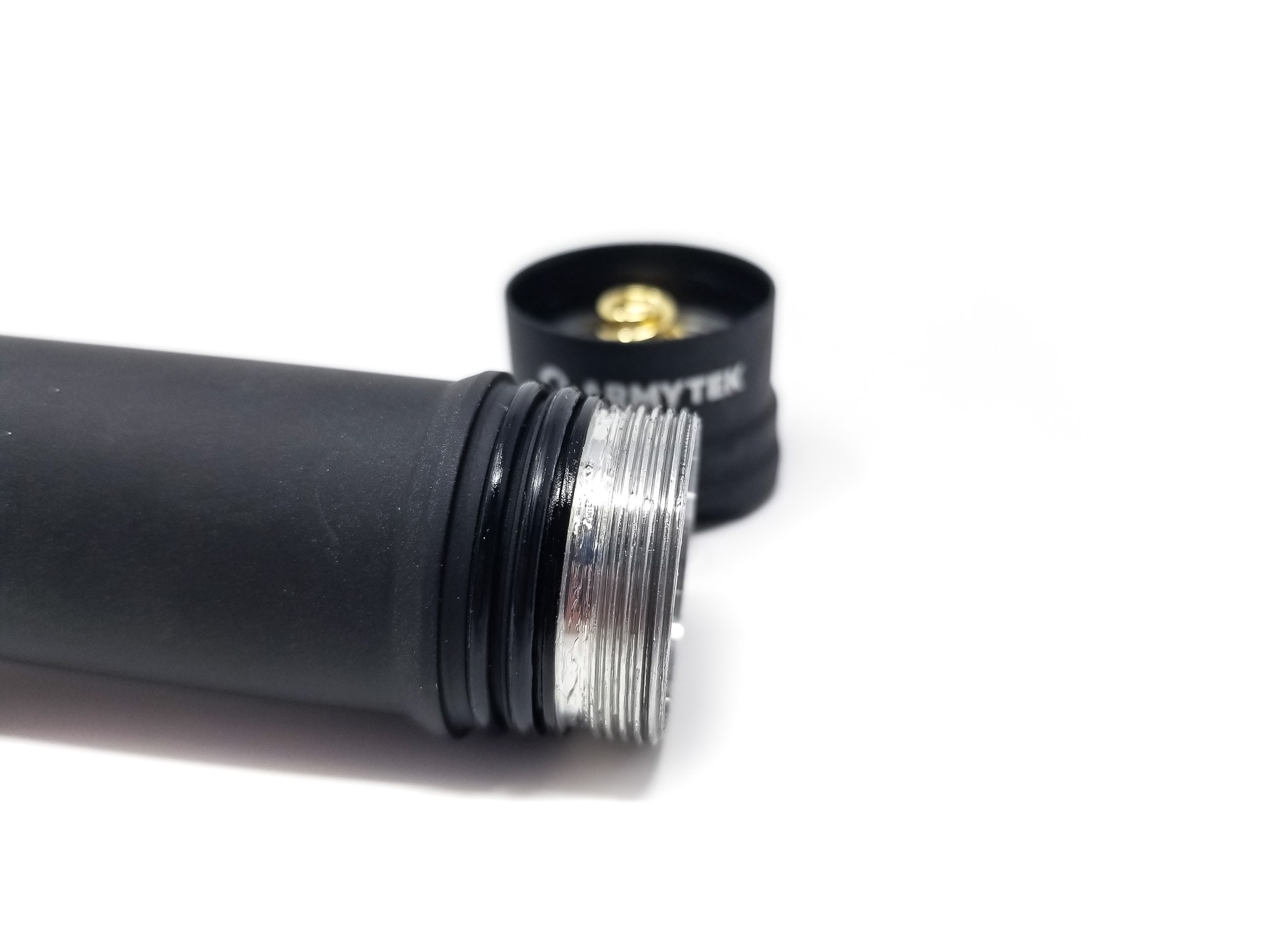
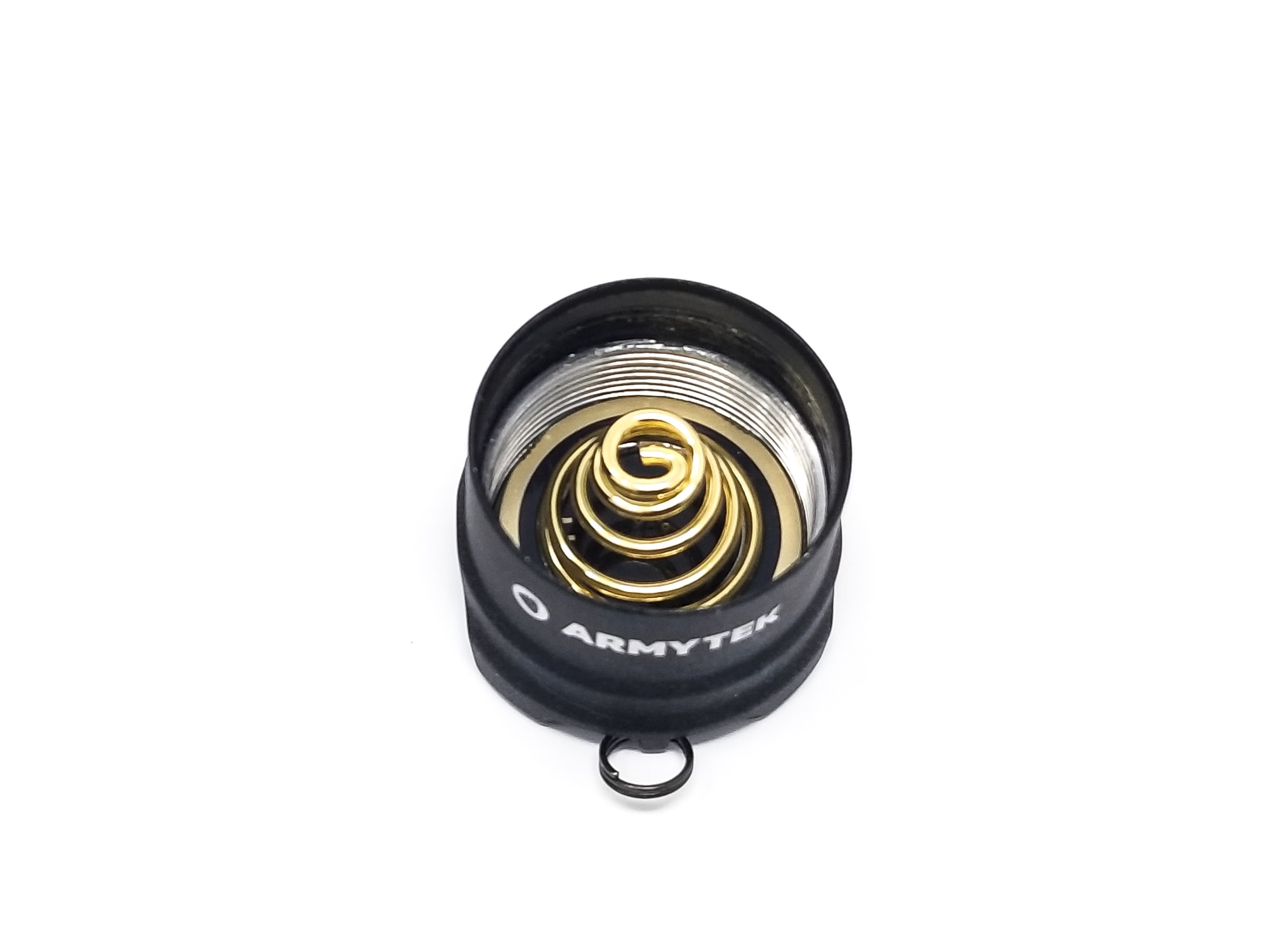
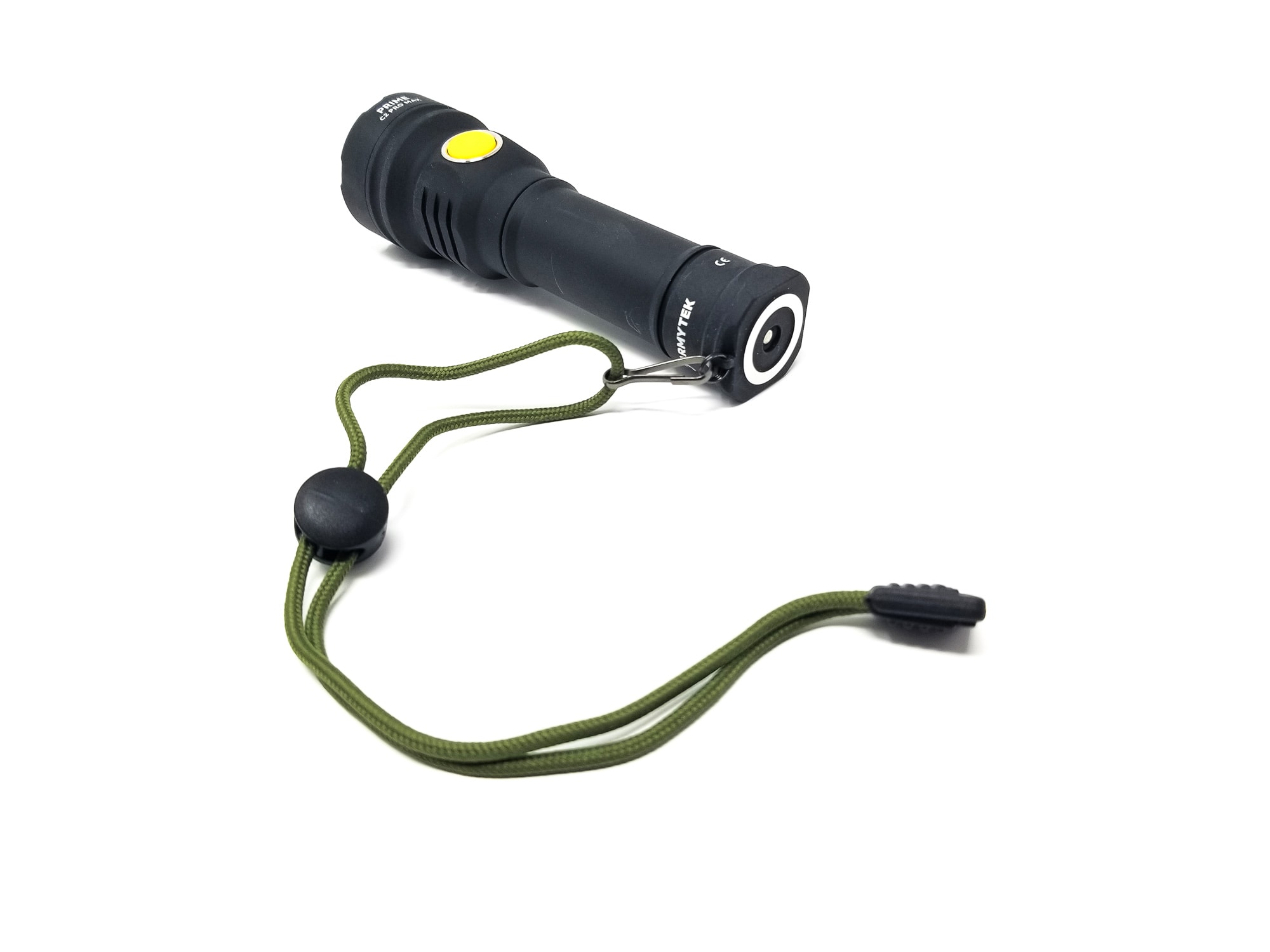
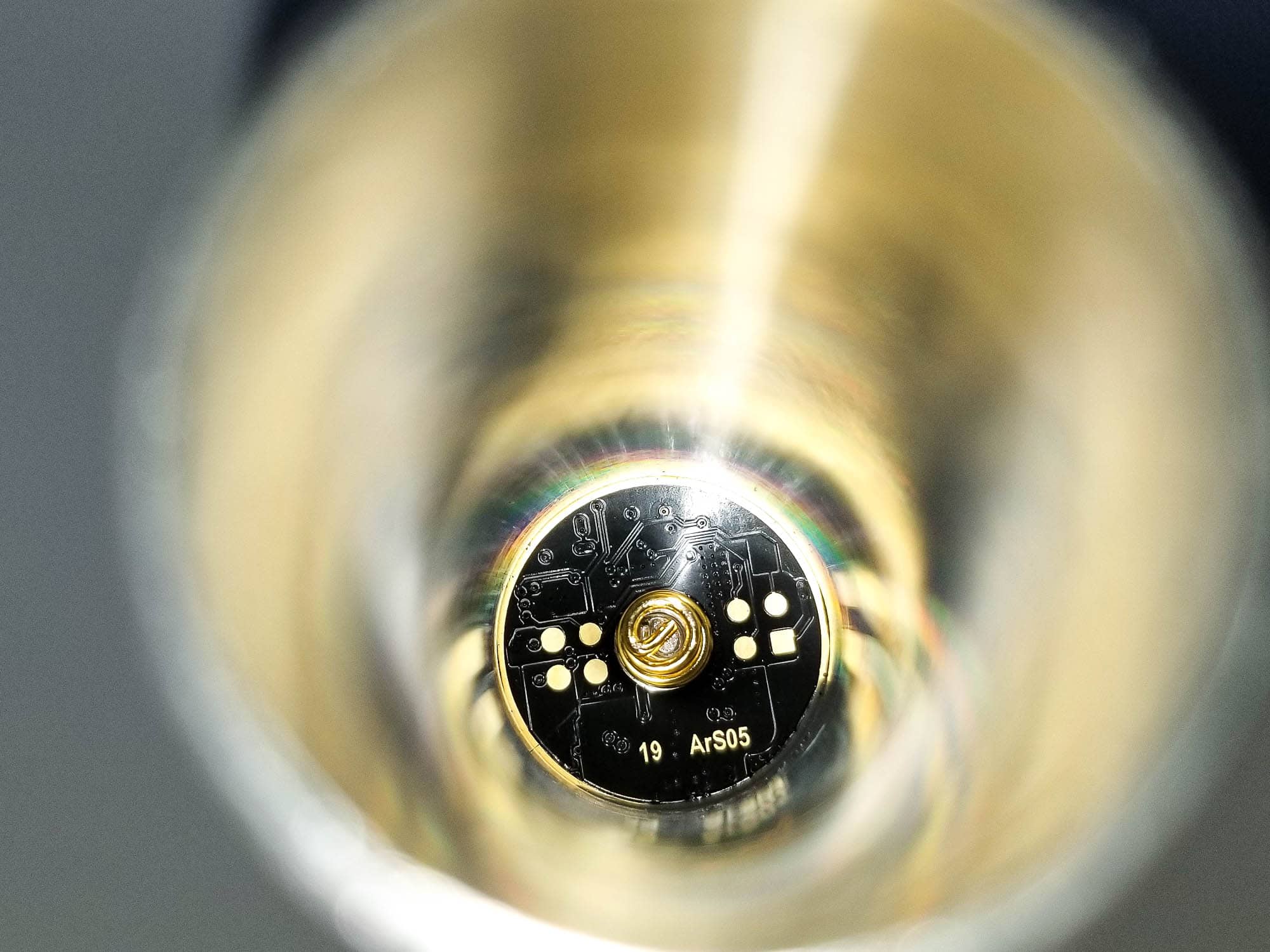
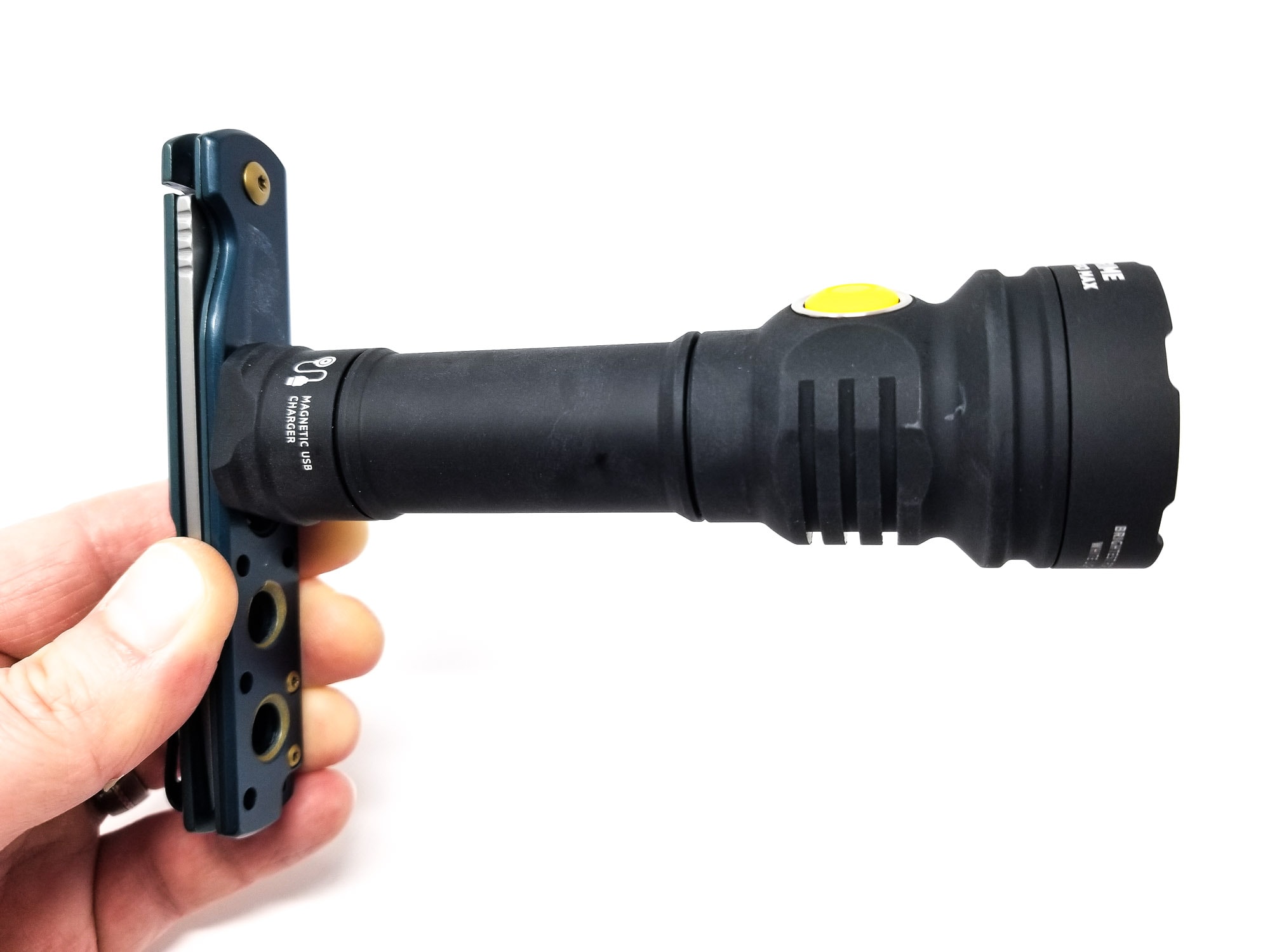

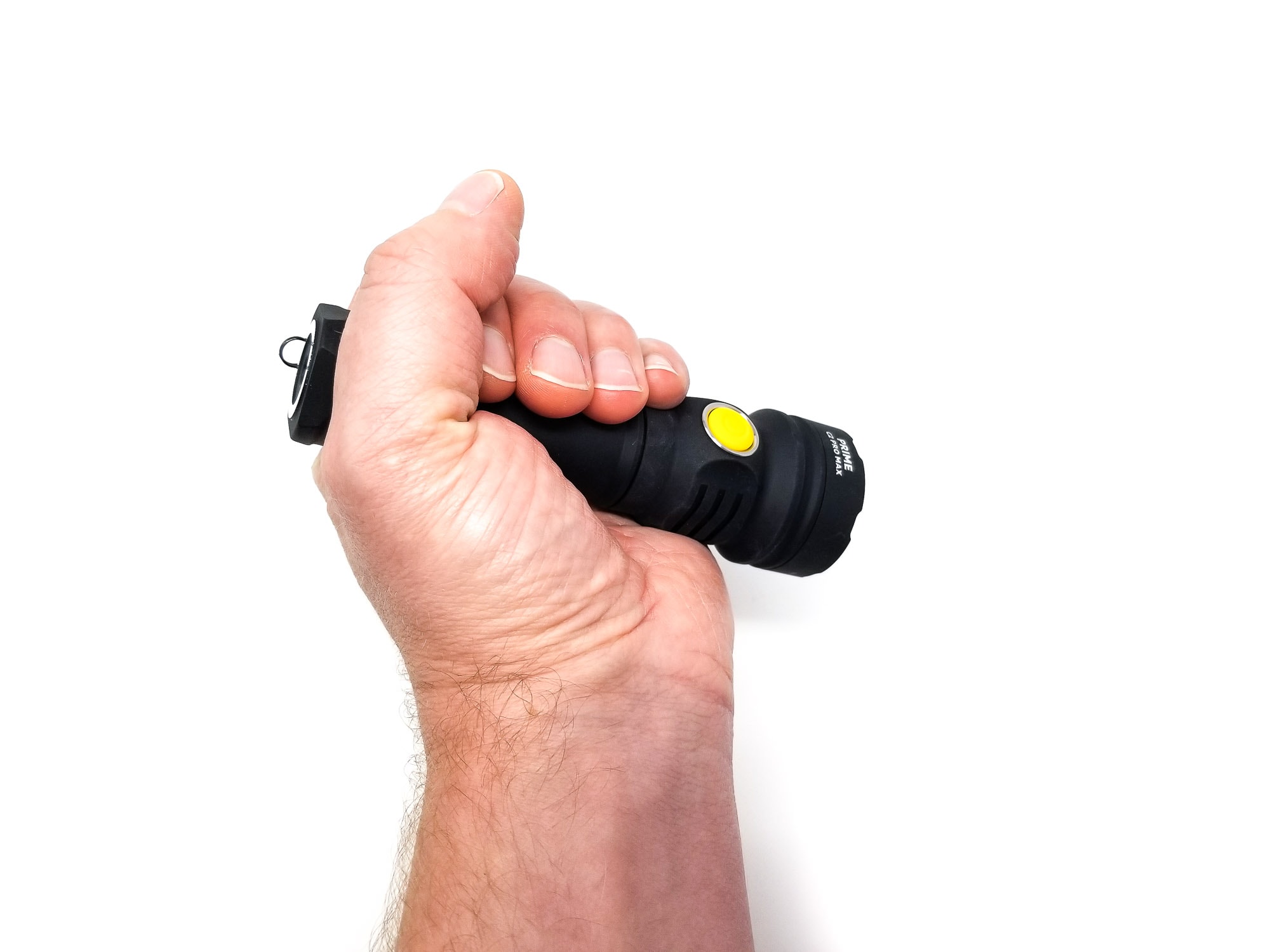
LED, Lens, Bezel, Beam, and Reflector
The Prime C2 Pro Max uses the Cree XHP70.2 LED. This LED has been around since about 2017, and has been featured (and copied) in a ton of single LED high output lights, so no surprise Armytek is using it here. The Prime is sporting the HD (domed) version of the 70.2, and this is a 7070 (7×7 mm footprint) quad die CSP type LED. It’s capable of very high output and runs on 6 or 12 volts. It has a low thermal resistance and when paired to a good driver can deliver very efficient output, or be direct-driven and produce many thousands of Lumens.
The light comes in either a cool white or a warm white version. The test light came in the cool white version, which has about 7% more output than the warm white version at the expense of a cooler tint. The reflector is a smooth (not textured like some XHP70.2 lights) unit with an AR coated mineral glass lens with a blue-greenish tint to it to help with the Cree tint shift. Since this is the domed gen 2 XHP70, you get a not-so-nice beam compared to the domeless variants, with tint shift transition from bright white spill to yellow corona to a bright hotspot. Honestly it’s not too bad, and expected for the XHP70.2. There’s a lot of useful spill and a huge hotspot making up a very useful beam with decent distance.
Spectral measurements:
I used the Opple Lightmaster Pro to measure the flashlight at 1 meter from the sensor.
| Mode: | CCT: | CRI Ra: | duv |
|---|---|---|---|
| Turbo 2 | 6572K | 71.5 | 0.0004 |
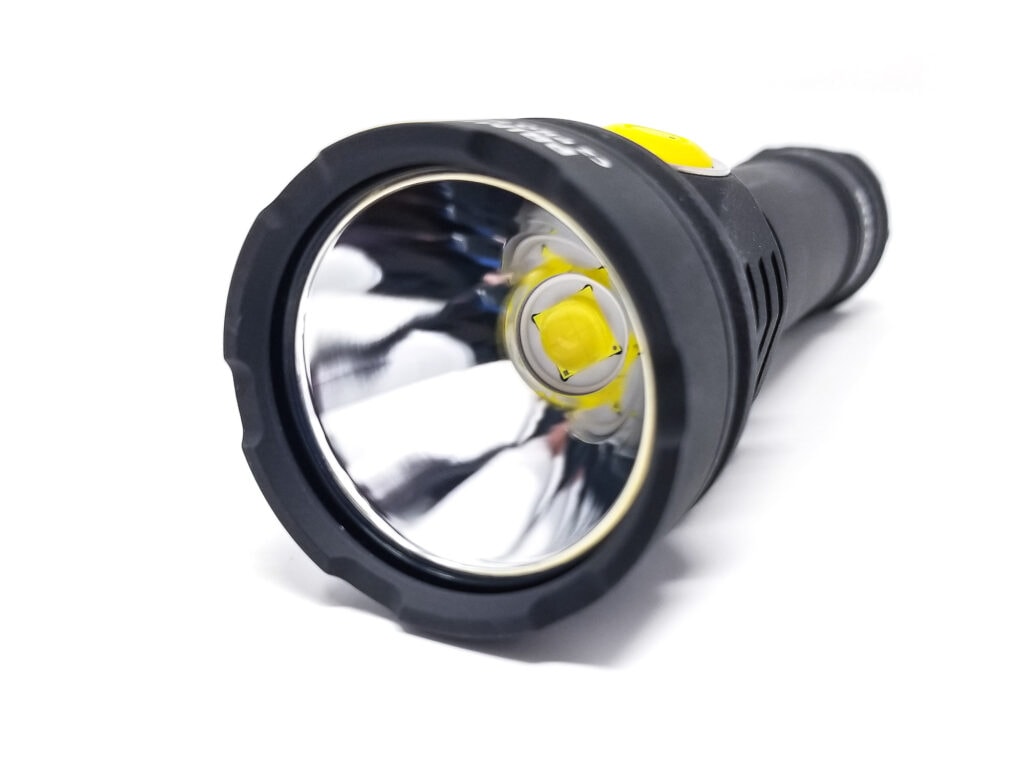
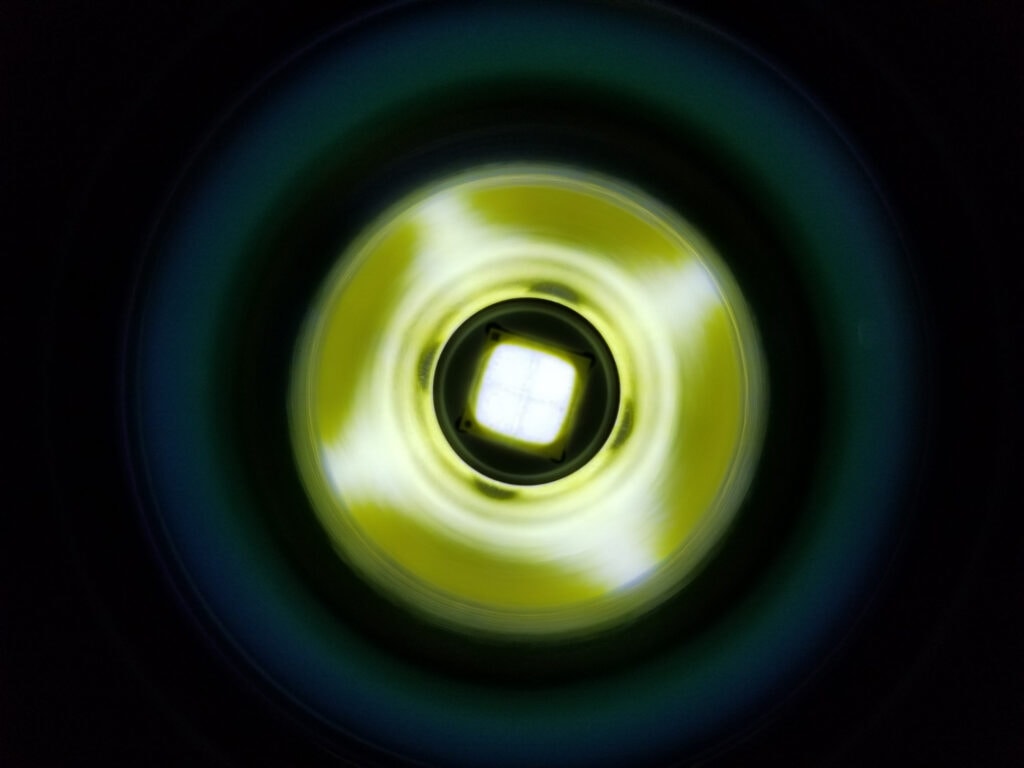
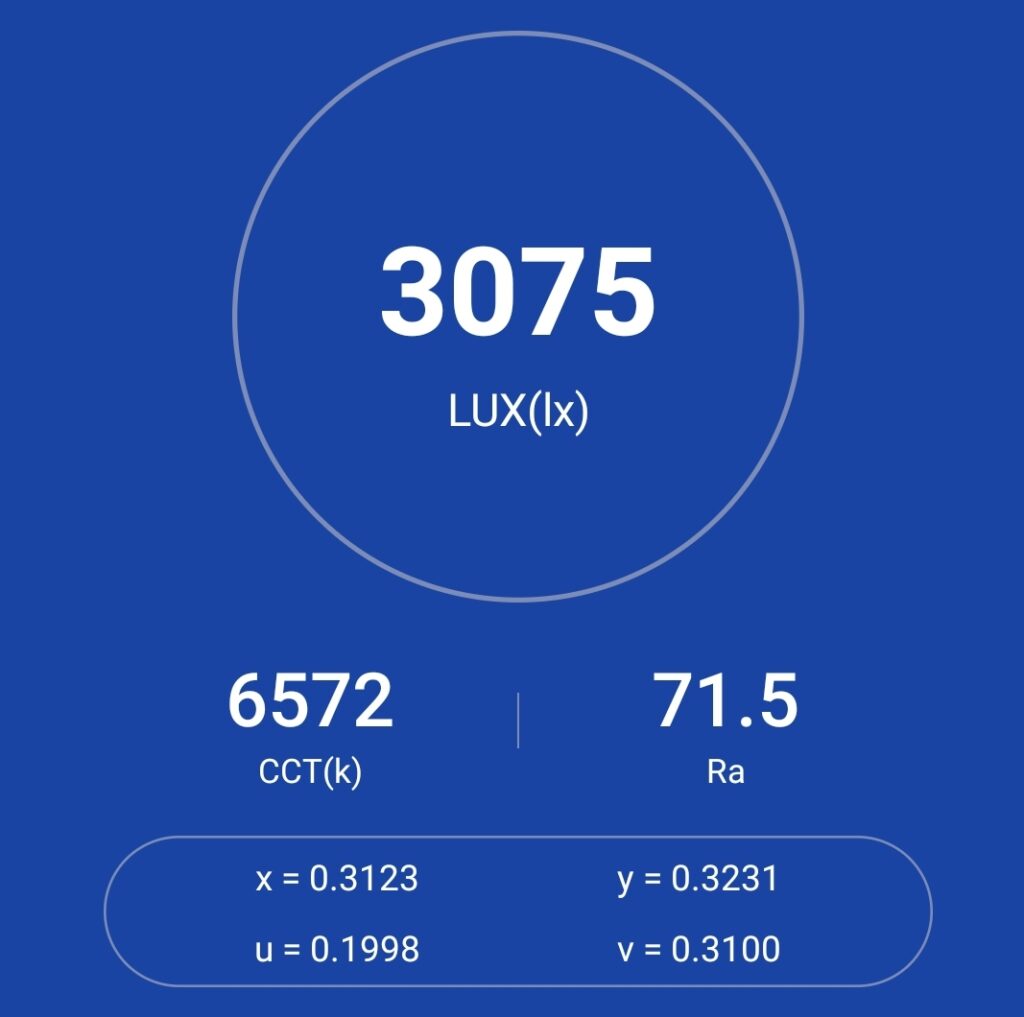

Dimensions and its competition
Dimensions:
| Millimeters | Inches | |
|---|---|---|
| Length | 133 mm | 5.2 in |
| Head diameter | 41 mm | 1.6 in |
| Body diameter | 25 mm | 0.9 in |
Dimensions are rounded to the nearest millimeter, and to the nearest tenth of an Inch.
Weight:
| Weight in grams | Weight in oz | |
|---|---|---|
| Without battery: | 131 g | 4.6 oz |
| With battery | 200 g | 7.1 oz |
Weight is rounded to the nearest gram, and to the nearest tenth of an Oz.
Flashlight size comparison with its competition:
Group 1 left to right: Olight Warrior 3S Limited Edition titanium, Thrunite T2, Acebeam E75, Armytek Prime C2 Pro Max, Thrunite TC20 V2, Fenix TK20R UE
Group 2 left to right: Acebeam P17 Defender, Thorfire C8, Armytek Prime C2 Pro Max, Chansky P50R
Group 3 reflectors left to right: Acebeam P17 Defender, Thorfire C8, Armytek Prime C2 Pro Max
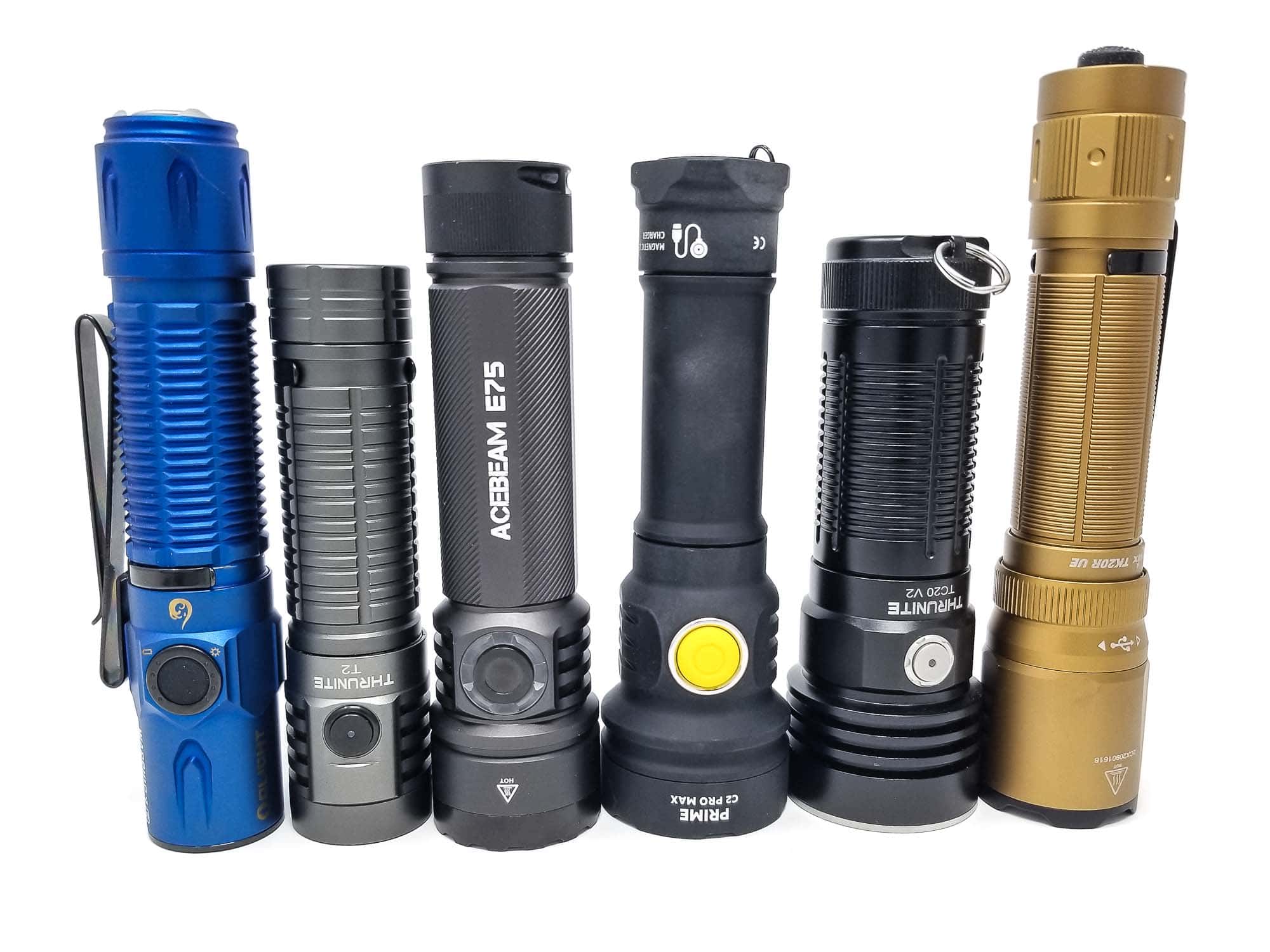
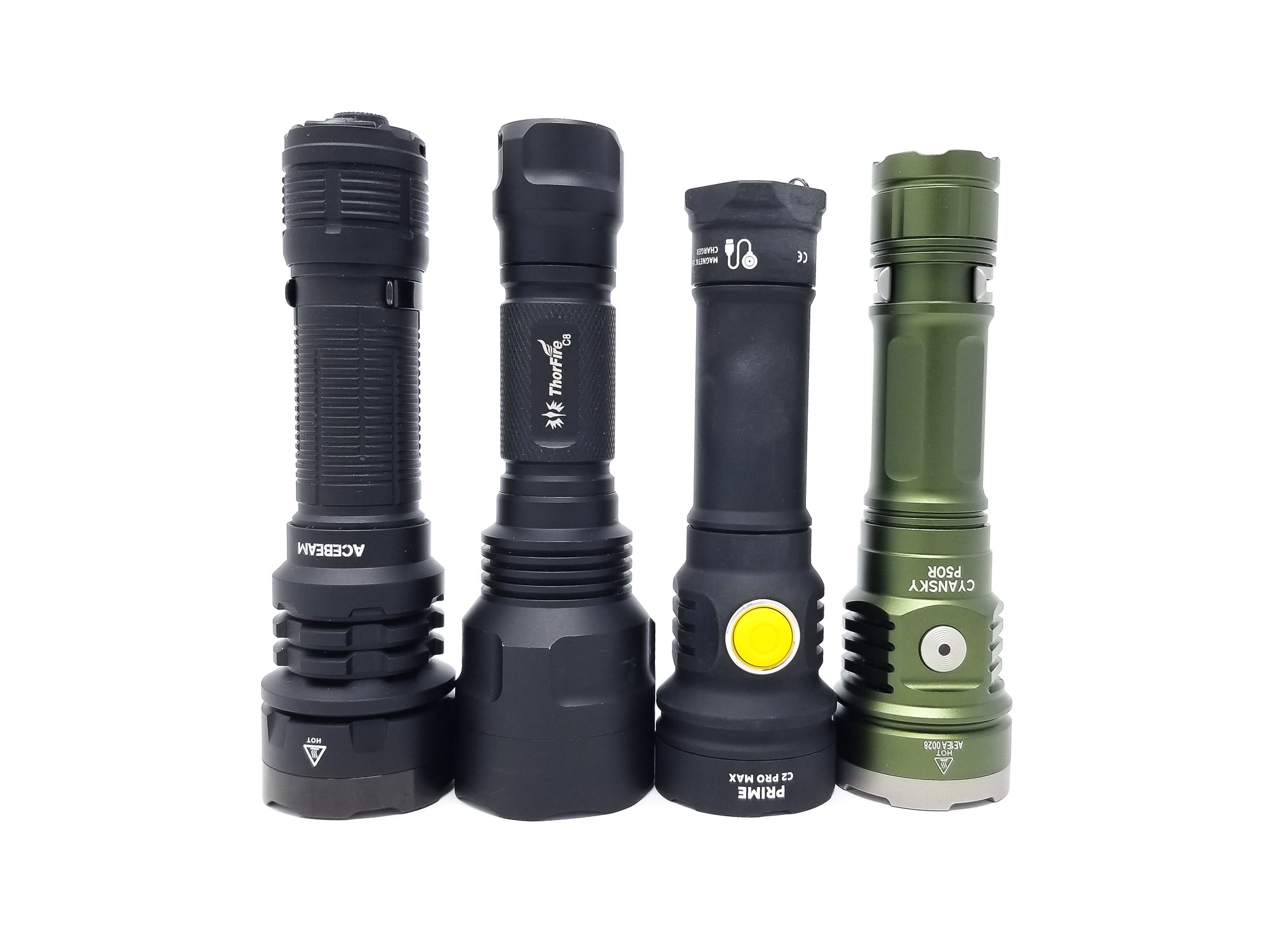
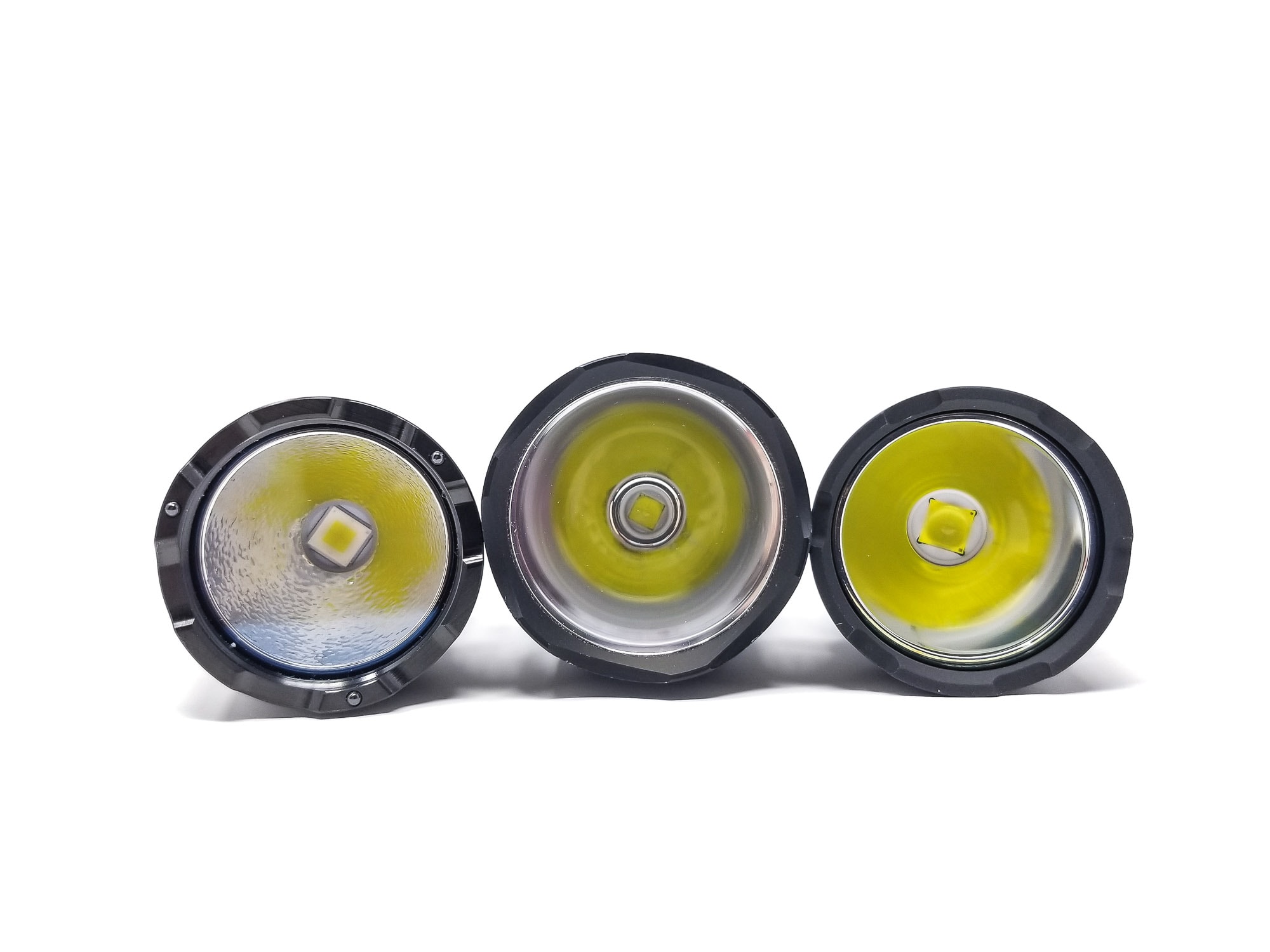
Armytek Prime C2 Pro Max Magnet USB UI: User Interface and Driver
The driver is going to be a boost driver to take the 4.2 volts from the single 21700 to 6 volts for the LED. It’s going to have fully regulated output, which is great for constant brightness as the battery discharges.
The UI can be a source of contention for some, since it’s a bit complicated, and a little unconventional, but nonetheless straightforward. It’s broken down into two groups: General and Advanced.
General has 6 fairly standard modes, and Advanced opens up 4 additional modes for a total of 10 including an additional Turbo level and 3 Strobe modes.In General Mode, it’s all very simple.
In Advanced mode, it gets a bit quirky, and took me some figuring out to get it down.
To switch between General and Advanced modes is pretty simple: With the light off, unscrew the tailcap ¼ turn. Press and hold the switch down while tightening the tailcap. When the tailcap is fully tightened, immediately release the switch (don’t hold it down after tightening the tailcap or it won’t work). To switch back, repeat.
Available modes in General Mode:
- Firefly 1, Firefly 2, Main 1, Main 2, Main 3, Turbo 2
Available mode groups in Advanced Mode:
- Group 1: Firefly 1, Firefly 2
- Group 2: Main 1, Main 2, Main 3
- Group 3: Turbo 1, Turbo 2
- Group 4: Strobe 1, Strobe 2, Strobe 3
Available blinky modes:
- Strobe 1 (full-brightness strobe), Strobe 2 (full brightness beacon), Strobe 3 (low brightness beacon)
From OFF in General Mode:
- Single click: Turns on in last memorized mode
- Press and hold: Turns on in Firefly 1. Continuing to press and hold cycles through Firefly 1-Firefly 2. Keeping the switch pressed will start on Main 1 and cycle to Main 2-Main 3
- Double click: Turbo 2
From ON in General Mode:
- Single click: Turns off
- Press and hold: Cycles through Main 1-Main 2-Main 3
- Double click: Turbo 2. Double click again to exit to last used mode
From OFF in Advanced Mode:
- Single click: Turns on in last memorized mode in the selected mode selection (Firefly, Main, Turbo, or Strobe)
- Press and hold: Turns on in Firefly 1. Keeping the switch pressed will continue to Firefly 2-Main 1-Main 2-Main 3-Turbo 1. Releasing the switch will select the mode. Long-pressing again will cycle through the Main modes again: Main 1-Main 2-Main 3. If releasing on Tubo 1, long-pressing again cycles through Turbo 1-Turbo 2
- Double click: Turns on in the Main mode group (Main 1, Main 2, Main 3)
- 3 clicks: Turns on in the Turbo mode group (Turbo 1, Turbo 2)
- 4 clicks: Turns on in the Strobe mode group (Strobe 1, Strobe 2, Strobe 3)
From ON in Advanced Mode:
- Single click: Turns off
- Press and hold (depends on the currently selected mode group): Cycles through the modes in the selected mode group
- Double click: Turns on in the Main mode group. Long-pressing cycles through Main 1, Main 2, Main 3)
- 3 clicks: Turns on in the Turbo mode group. Long-pressing will cycle through Turbo 1, Turbo 2
- 4 clicks: Turns on in the Strobe mode group (Strobe 1, Strobe 2, Strobe 3)
Mode memory:
- Yes. Remembers all modes including Firefly, Turbo, and Strobe
Shortcuts:
- To Firefly: Long press from off in any mode
- Double click: Turbo 1 in General Mode
- 4 Clicks: Strobe 1 in Advanced Mode
Low voltage warning/protection:
- None specified in the manual, but the light drops to a very low level around 3 volts (what looked like Firefly 1)
Strobe/blinkies
- Strobe 1, Strobe 2, Strobe 3
Lock-out mode:
- Mechanical lockout by unscrewing the tailcap ¼ turn
PWM
- None visible by eye
Additional/summary info on the UI: I thought Anduril was complicated! I’m also getting some undertones of Zebralight’s UI. While this UI isn’t as functionally complex as Anduril, mastering it took some careful deciphering of the fairly sparse user manual (note to Armytek: A function diagram would be useful here-or at least a chart of the mode sets).
There’s a lot of functionality built into the Prime C2 Pro Max UI. You get a General mode with a pretty standard set of easily-accessed modes, and an Advanced mode with many mode sets that take practice to master, but once you get it, you appreciate what Armytek did here since it makes the UI extremely flexible, but also causes some conundrums, like being able to select modes in an adjacent mode group without switching to them the usual way. I think keeping the light in General Mode will be good enough for most users, and if Strobes are your thing, you get 3, and those are only available in Advanced Mode (thanks Armytek).
I didn’t find it too beneficial to have two Turbo settings either, since the difference between Main 3 and Turbo 1 isn’t that marked, and I don’t see the purpose of having a dim beacon flasher (Strobe 3) either. All of the usual features are here like thermal regulation to 58 C and (I hope) LVP, but none was mentioned anywhere.
Another thing to note, the lighting mode selection doesn’t last if you let the light sit without a battery for a full day or two.
Armytek Prime C2 Pro Max Magnet USB Charging and batteries
The Prime C2 Pro Max sports a couple of battery options. By default, it’s a 21700 light, but with the included adapter, you can also run an 18650. The light included an Armytek branded 5000 mAh 21700 cell it says it good for 15 amps discharge. It doesn’t have a protection board, which is extremely rare for lights of this type, since all the big brands add PCBs to their bundled cells. It’s a safety thing and keeps the light safe.
The good news is you can use any 21700 you want in the Prime C2 Pro Max: Flat tops with PCBs, button tops, even 77 mm long cells, while snug,fit. For charging, Armytek adopts an Olight-type (yep, proprietary) magnetic charging solution. The kit included a charging cable consisting of a USB A plug on one end and the magnetic contact/charging head on the other end of a 12 inch flat cable lead. The head has a flat metal bottom with a central pogo contact that magnetically attaches to an outer ring and a central contact on the tailcap. No charging current is specified, but Armytek says the battery should be charged in 5 hours 20 minutes, which is embarrassingly slow these days. To charge, you need to unscrew the tailcap ¼ turn. If you connect the charger without doing that, it won’t charge. The connector has two LED indicators (one shaped like a lightning bolt, one shaped like a electrical plug) for charge status/battery state, as follows:
- Charger not connected
- Solid green light (standby)
- Charger connected
- Blinking green light indicates battery voltage check (the charger checks the cell voltage before charging)
- Blinking red: Battery ready to charge, but the tailcap hasn’t been loosened ¼ turn
- Blinking orange: Fault (dirty threads, bad connection, power supply issue)
- Solid red: Normal charging
- Solid orange: Reduced charge current
- Solid green: Charge completion
My testing showed the charging connector limits charging speed to 1 amp, even when connected to a QC2.0 USB port. Charging after a runtime took a hair over 6 hours. That’s pretty slow, and while it ensures the cell will last a very long time, aint nobody got time for that. I resorted to charging the cell in my Vapcell S4+ since I could charge it at 2.5 amps. The termination voltage was 4.13 volts and the meter showed 4866 mA added to the cell.
| Charge type | Fits | No fit | Charge time |
|---|---|---|---|
| Proprietary magnetic | Standard flat top, protected, unprotected, button top, built-in charging | 77 mm cells fit, but were tight | 6+ hours |
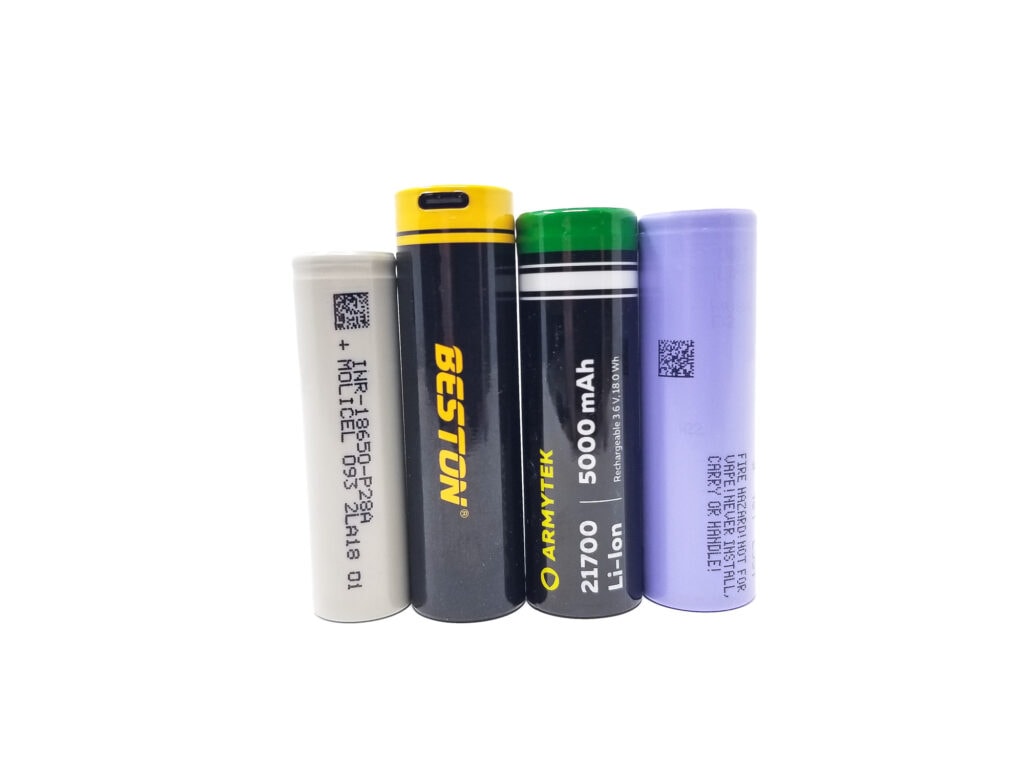
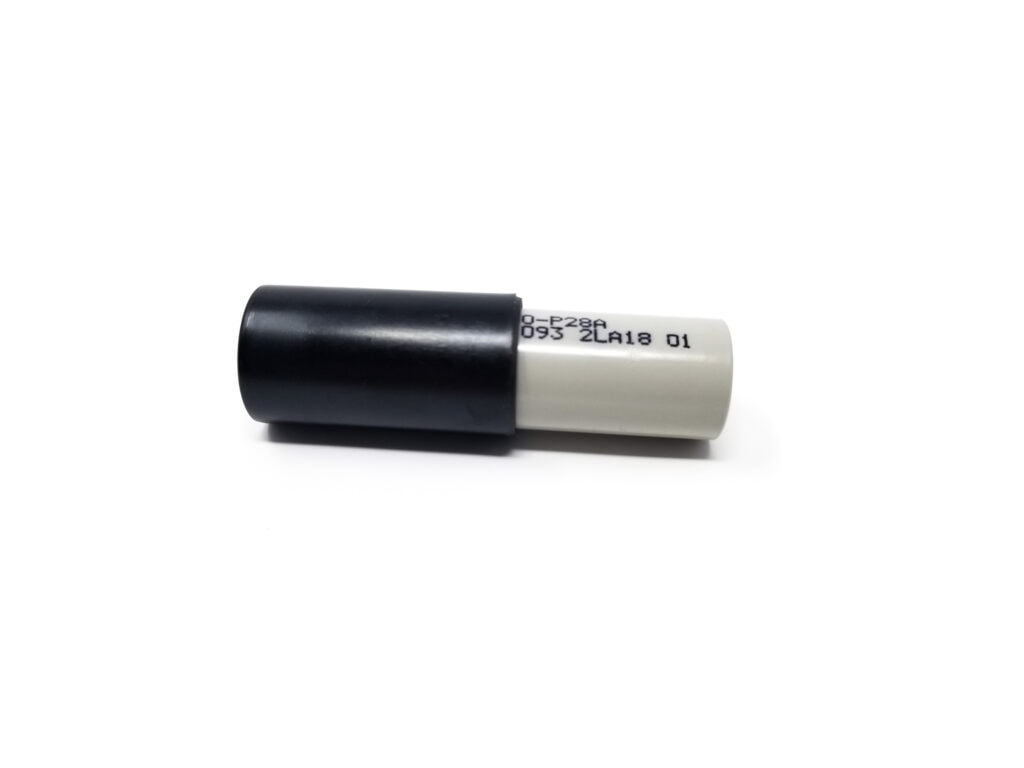
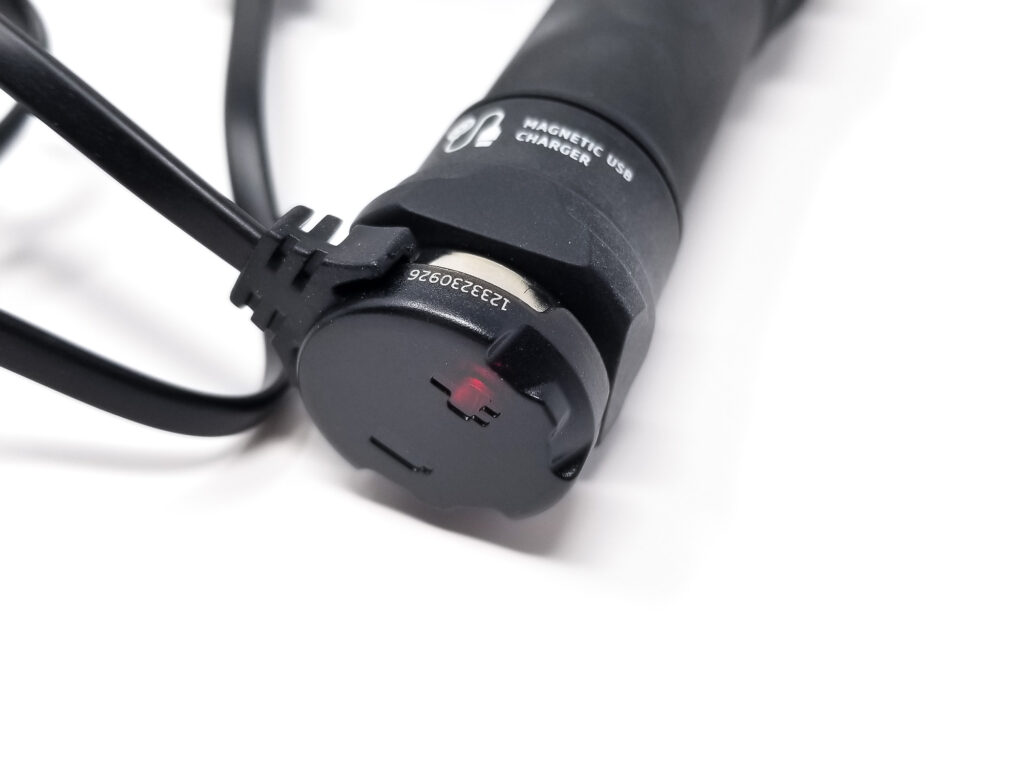
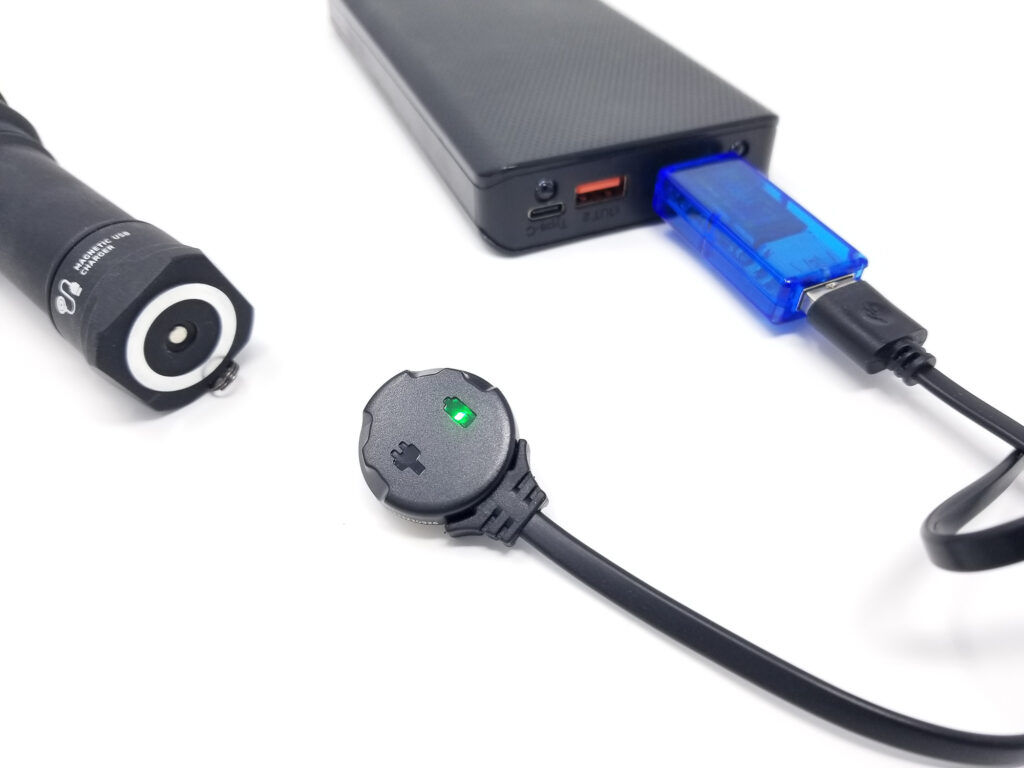
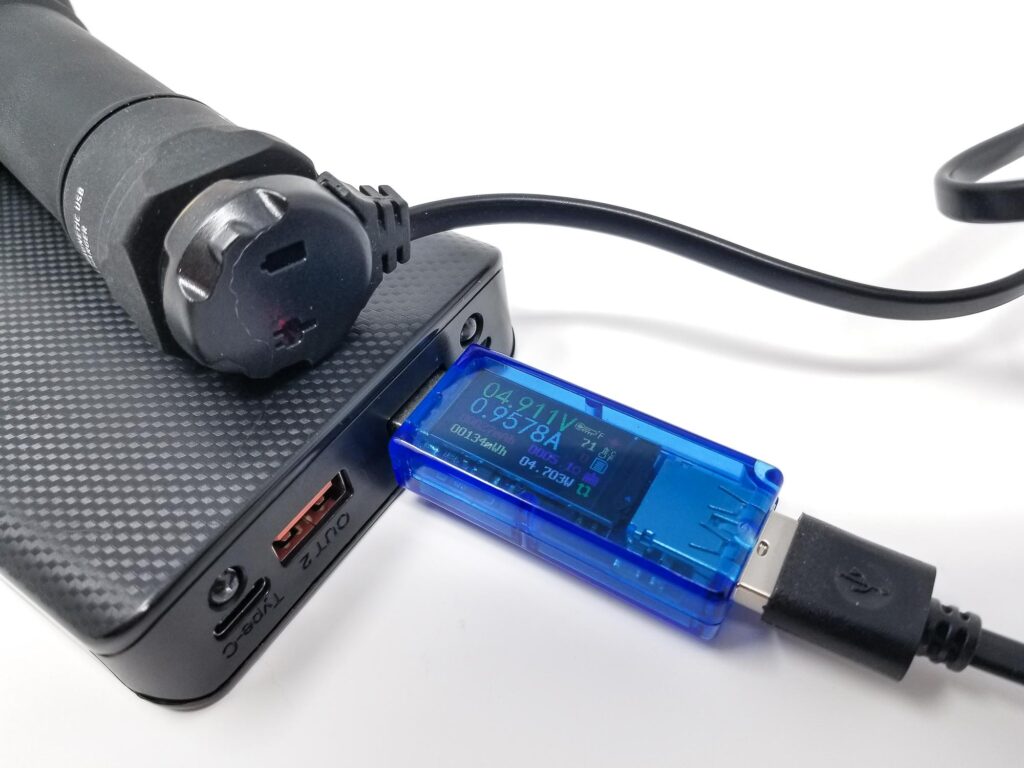
Performance test
Lumen measurements
How Lumens are Measured: Understanding ANSI FL1 Standards How Lumens are Measured: Understanding ANSI FL1 Standards: The ANSI FL1 standards specify that output in lumens should be measured 30 seconds after turning on, as this is the standardized time for measuring brightness according to the industry standard. This is why we focus on this part in our measurements. The ANSI FL1 standards require an ambient temperature of 22 ± 3°C. We record the ambient the ambient temperature to identify potential reasons for any observed discrepancies.Lumens are measured in my 30 cm integrating sphere with a Digi-Sense 20250-00 data logging luxmeter. The sphere has been calibrated with a Convoy S2+ measured to 260 Lumens and the figures are within 10% of actual. I measured current using my Thsinde B18B+ digital multimeter with 14 gauge wires plugged into the meter and higher currents with my FY219 clamp meter using a 10 gauge wire in a loop. Measurements were taken using the included fully charged 5000 mAh 21700.
| Mode | Amps at start | Specs | turn on | 30 sec | 10 minutes |
|---|---|---|---|---|---|
| Firefly 1 | 9.3 mA | 0.4 | N/A | N/A | – |
| Firefly 2 | 18.9 mA | 7 | 9 | 0 | – |
| Main 1 | 65 mA | 45 | 33 lm | 33 lm | – |
| Main 2 | 219 mA | 150 | 126 lm | 126 lm | – |
| Main 3 | 550 mA | 450 | 396 lm | 387 lm | 387 lm |
| Turbo 1 | 1.84 A | 1300 | 1188 lm | 1179 lm | 1152 lm |
| Turbo 2 | 8.4 A | 4000 lm | 1170 lm | 3690 lm | 810 lm |
Parasitic drain:
- 14.4 µA
The LED isn’t being driven particularly hard in this case at only 8.4 amps, but that’s okay! Firefly 1 was too dim, and my small sphere can read down to about 0.8 Lumens, so it’s definitely below that. The rest I’m coming in low. The output is laminar and fully regulated, so that’s great, but the output on Turbo 2 does a weird ramp up to full brightness over about 10 seconds, and the sustained outputs are good for a light this size.
Temperatures also look good, never going over 60 C for Turbo 1 or Turbo 2, staying around 50-55 C at the head, with the rest of the light being hand-friendly. The output drops off sharply for LVP, shutting down a short time later. The light was usable after the tests, albeit at very reduced outputs. The battery was discharged down to a very conservative 2.9-3.0 volts after the test.
Armytek Prime C2 Pro Max Magnet USB Battery Life: Runtime graphs
How Runtimes are Measured: Understanding ANSI FL1 Standards About ANSI FL1 runtime standards: The runtime is measured until the light drops to 10% of its initial output (30 seconds after turning on). This does not mean that the flashlight is not usable anymore. The last column shows how long the light actually works till it shuts off. If there is a + symbol, it means that the test was stopped at that particular point, but the light was actually still running. This happens on certain occasions, with certain drivers, firmware, or batteries.| Mode | Specified runtime | Measured runtime ANSI | Time till shut off |
|---|---|---|---|
| Main 3 | 6h 25m | 7h 20m | 7h 20m |
| Turbo 1 | 3h | 2h 41m | 4h 59m |
| Turbo 2 | 3h 4m | 2h 31m | 2h 40m |
The runtimes for Turbo 1 and 2 don’t track with my testing, but still not bad for a high power light. Main 3 mode did better. The LVP is abrupt, as mentioned previously, shutting the light off after dropping to a low level, but it was still usable after the test at low output.

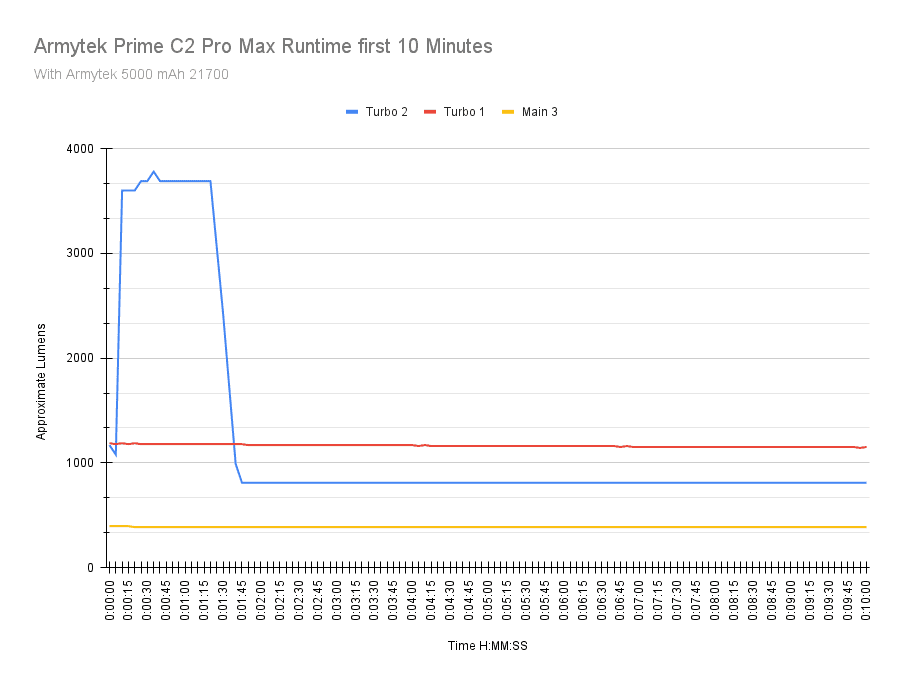
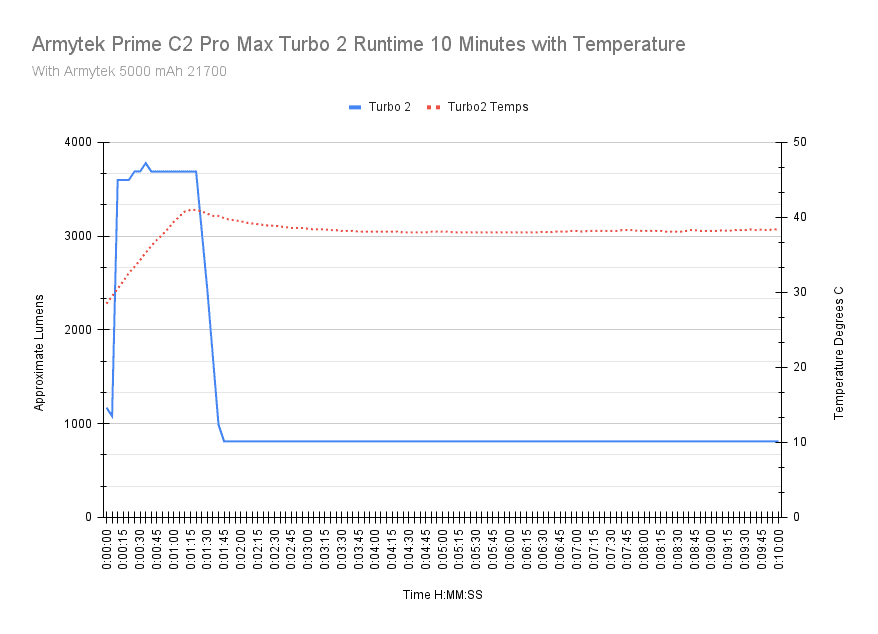

Compared to other similar lights (the Acebeam P17 Defender, Thrunite T2 and TC20 V2), The C2 Pro Max was a bit behind the Acebeam and the TC20 V2, and performed similarly to the T2. Overall, good performance for a small, high output light, but I think Armytek could have coaxed a little more out of it.
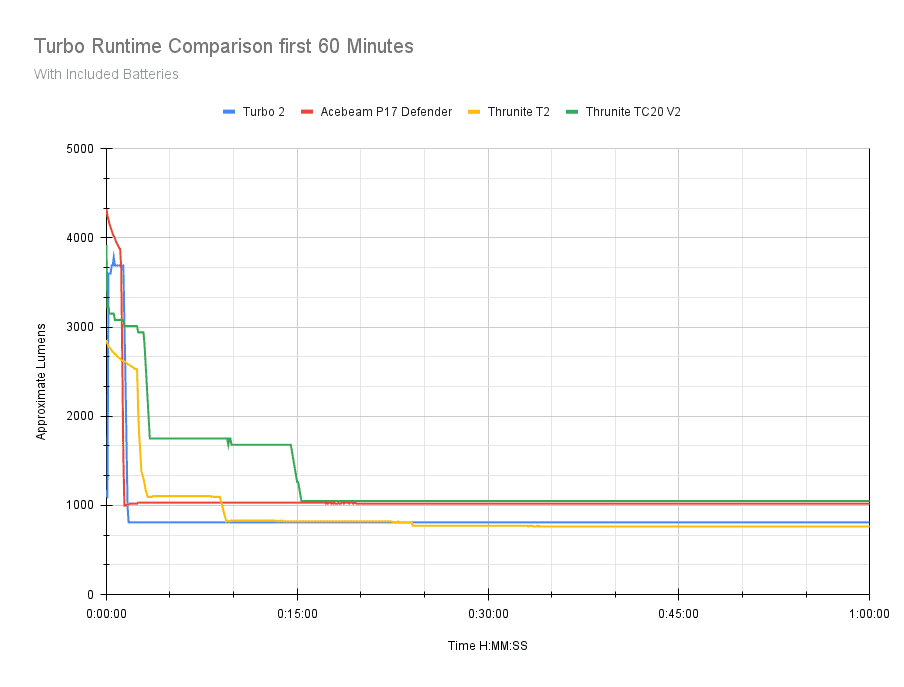

Peak beam intensity and beam distance measurements
About Peak beam intensity: Understanding ANSI FL1 Standards About peak beam intensity The calculated value of distance in meters at which the flashlight produces a light intensity of 0.25 lux. (0.25 lux is about the brightness of a full moon shining on an object). This means that the intensity has decreased so much, it becomes difficult to see darker objects, or objects that don’t reflect light. The columns ‘Meters’ and ‘Yards’ use rounded numbers.Beam distances are measured using a Uni-T UT383S luxmeter measured indoors at 5 meters using the included fully charged 5000 mAh 21700.. Measurements taken at 30 seconds.
| Mode | Specs | Candela measured | Meters | Yards |
|---|---|---|---|---|
| Firefly 1 | ? | N/A | N/A | N/A |
| Firefly 2 | ? | N/A | N/A | N/A |
| Main 1 | ? | 150 | 24 | 26 |
| Main 2 | ? | 700 | 53 | 58 |
| Main 3 | ? | 2525 | 100 | 109 |
| Turbo 1 | ? | 6700 | 164 | 179 |
| Turbo 2 | 260 m | 23,375 cd | 306 m | 335 |
There aren’t any intensity figures included in the specs for the Prime C2 Pro Max, just a 260 meter figure provided amongst the spec blurbs on the box (probably for Turbo 2). The Firefly modes are too dim at 5 meters to show up on the luxmeter. I got over the specified number for (what I imagine) is Turbo 2. 306 meters isn’t bad for a compact light with a floody LED.
Beamshots
Camera settings and distance: Photos taken with my Samsung Galaxy Note 8 with the camera set to ISO 200, 0.3s, and 5000K WB. The fence is 40 meters distant.
Beamshots of the following general purpose-use LED flashlights compared:
- Armytek Prime C2 Pro Max Magnet
- Thrunite TC20 V2
- Acebeam P17 Defender
- Fenix TK16 V2
- Fenix PD40R
- Olight Warrior 3S Limited Edition copper
Please note that beamshots are mainly intended to showcase the beam pattern and beam quality, rather than overall performance. These images are typically taken directly after activation, and do not fully represent its overall performance. For accurate performance metrics, such as output, beam distance, and runtimes, you need to look at the performance section of this review.

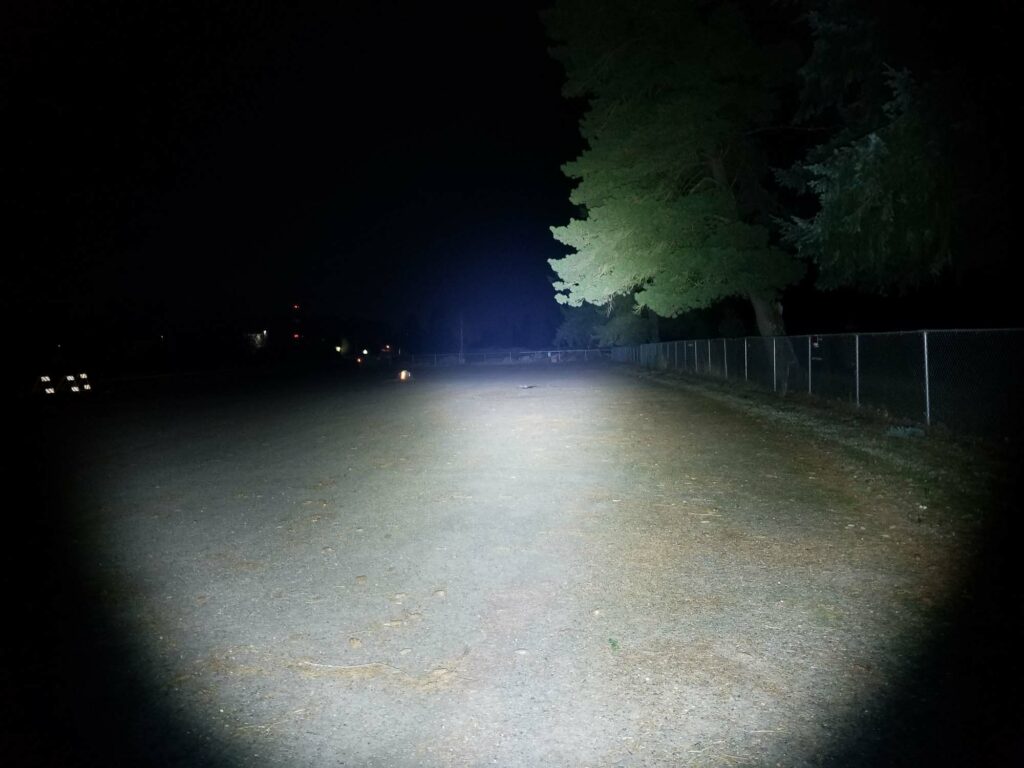




Disclaimer: This flashlight was sent to us for review at no cost by Armytek. We have not been paid to review, nor have we been holding back on problems or defects.
Final Verdict
Pros
- Meticulous design and build quality
- Excellent fit and finish
- Decent sustained output
- Good handling
- Can use non-proprietary batteries
- Beam is great for general purpose
- Available in a warm white tint XHP70.2
Cons
- UI is complicated and the user manual doesn’t help much
- Recharging is slow
- Didn’t meet output specs
- Proprietary charging solution
Explanation on star ratings:
1: Avoid: a match would be a better choice – 2: Poor: significant defect or issues; almost unusable – 3: Average: some defects or issues; but still usable 4: Good: recommended (minor issues) – 5: Great: highly recommended

4 stars: ★★★★
While our star rating provides a reliable indicator, we encourage you to read the full review to make an informed decision based on your own needs and preferences.
Before this review, Armytek was a relatively unknown brand to me, but now I’m glad to have made their acquaintance since these are well-put together lights with decent performance and great build quality. I can definitely see the German design and engineering at work here since the light is meticulously designed and well thought out with a simplistic, no-frills design.
I liked the handling dynamics, and the lightness and the grippy finish was great for traction with bare hands despite the lack of knurling. The thermal regulation is super-tidy and keeps the light hand-friendly for extended runs on Turbo 2, and the output is fully regulated with decent sustained output. While I’m not a fan of magnetic tailcaps or proprietary charging solutions, I am glad Armytek didn’t stick it with a proprietary battery, so thanks Armytek for the nod towards flashlight enthusiasts.
I get that Armytek wanted a simple design without the added complexity and durability compromises with a traditional external charging port though, and that appeals to some buyers. The recharging is also really slow for a mainstream, pro-grade flashlight in 2023. I’d like to see at least 10W charging or better for a 5000 mAh 21700. The output on Turbo 2 doesn’t match the competition, but that’s fine since it keeps the temperatures down.
The UI takes some getting used to and that’s not helped by the lack of detailed operating instructions, but with some finagling and trial-and-error, it’s serviceable and pretty flexible. I wouldn’t market this as a tactical or duty-use light since the UI is too complex for that application.
Overall, this is a well-thought-out flashlight, and I really can’t fault it too much. I think with some tweaking, it would be an excellent general purpose or utility flashlight. 4 stars for the Prime C2 Pro Max Magnet.
Buy your Armytek Prime C2 Pro Max Magnet USB with a discount
Get 15% off, by using our exclusive 1lumen discount code: lumen15
1lumen selects and reviews products personally. We may earn affiliate commissions through our links, which help support our testing.